Looking at Prehistory:
Indiana's Hoosier National Forest Region, 12,000 B.C. to 1650
|

|
Looking at Prehistory:
Paleoindian Period: ?12,000 to 8,000 B.C.
Paleoindian peoples are represented by several
cultures. Scattered sites and tools from many of these have been found
in southern Indiana, but most Paleoindian sites are quite small with few
tools and other remains to inform on their lifeways.
Clovis culture is the best known of the Paleoindian
period and was a successful hunting tradition that emerged from the
first peoples to enter the New World from Siberia. The first peoples
probably entered North America along the Pacific Coast and through the
interior of Alaska thousands of years earlier perhaps when massive
glaciers of packed snow were beginning to cover the land causing ocean
levels to drop three hundred feet lower than they are today. The Clovis
culture developed probably several thousand years after people were
already actively exploring the New World. Clovis people apparently lived
in small groups and moved their camps frequently in search of game and
plant foods.
Clovis hunting camps and tool manufacturing sites are
distributed from the Atlantic to the Pacific and from Alaska to Florida
across all types of landscapes. The basic Clovis tool kit includes the
distinctive Clovis type projectile point, along with large bifacially
flaked tools and unifacial blades for butchering game, and side scrapers
and end scrapers for cleaning and preparing hides for clothing and
shelter (Figures 17-18). They also used bone, antler and ivory for tools
made from the animals they killed, but these are not often preserved
except in wet sites, such as springs in Florida and Arizona and frozen
sites in the Arctic in environments where bacteria and other organisms
cannot destroy the evidence. So far, no perishable Clovis artifacts
have been found in Indiana, but many Clovis
projectile points and other stone tools have been collected, indicating
this part of North America was just as important as other areas for
Clovis survival and settlement.

|
|
Figure 17: Clovis and later Paleoindian period Quad
and Beaver Lake projectile points from sites in southern Indiana. The
Clovis point shown in the lower right was recently recorded and donated
to the Glenn A. Black Laboratory of Archaeology.
|

|
|
Figure 18: Tools used during the Paleoindian period.
These include an end scraper, side scraper, unifacial butchering knife,
and "rat-tail" tool (above) perhaps for hafting into a handle for use as
a scraper.
|
The environment in Indiana at the close of the Ice
Age was much colder than today. Studies of pollen preserved in mud and
peat in the bottom of ancient ponds and lakes show that spruce and pine
forests covered much of the land with intervening open steppe-like
grasslands. This environment was home to the mastodon, mammoth, musk
ox, ground sloth, caribou, dire wolf, peccary, saber-tooth cat and a
variety of smaller game animals (Figures 19-20). By about 8,000 B.C.,
the glaciers that once covered the Midwest had melted back into Canada
and basically all of the larger animals were extinct by the time the
environment finally changed to the hardwood forest of today. Animals
such as the caribou and musk ox still survive in the far north
today.

|
Figure 19: Ice Age Animals including mammoth,
mastodon, dire wolf, two types of peccary, and saber-toothed cat. All of
these animals went extinct at the end of the Ice Age (Modified from
Lange 2002: 95, 106, 161, 167).
Columbian mammoth
Mammuthus Columbi
American mastodon
Mammut americanum
Dire wolf
Canis dirus
|
|
Long-nosed peccary
Mylohyus nasutus
Flat-headed peccary
Platygonus compressus
Saber-toothed cat
Smilodon fatalis
|
|

|
Figure 20: Ice Age Animals including caribou,
musk ox, ground sloth, and giant short-faced bear. The ground sloth and
giant short-faced bear went extinct at the end of the Ice Age. Musk oxen
and caribou still live in the arctic today (Modified from Lange 2002:
83, 101, 148; and Pielou 1991:145).
Caribou
Rangifer tarandus
Jefferson's ground sloth
Megalonyx jeffersonii
|
|
Musk ox
Ovibos moschatus
Giant short-faced bear
Arctodus simus
|
|
The hill country of south-central Indiana
encompassed by the Hoosier National Forest is a very unique part of
Indiana (Figure 21). This region is known for its caves, crevices, and
other natural traps where now extinct animals entered and eventually
died. Their bones accumulated with sediments, leaving an important
record of the natural history of the region. Some of these include the
Harrodsburg Crevice and Knob Rock Cave in Monroe County and Megenity
Peccary Cave in Crawford County. The remains of giant ground sloth, dire wolf,
peccary, saber-tooth cat, and other extinct animals have been found in
these natural traps and pit caves (Figure 22).

|
|
Figure 21: A small rockshelter overlooking the Salt Creek Valley, Monroe
County, IN. Investigations determined the shelter to be a shallow and
disturbed accumulation of sediments that contained evidence of sporadic
use during the Archaic period. Interestingly, the site also contained
small fragments of preserved bone and charcoal. Some of the bone is
thought to be Pleistocene in age and could have been left in the shelter
by Ice Age predators. Indiana University field school, 1978.
|

|
Figure 22 (left): An entrance to Harrodsburg Crevice now covered by soil
and grass (Photo by the author). The crevice extends to an unknown depth
and may connect with a large cave system. During the Late Pleistocene
(Ice Age), solution cavities formed within the Salem Limestone and some
with steep walls became natural traps from which unfortunate animals
could not escape.
The Harrodsburg Crevice has produced the remains of fossil animals
including saber-toothed cat, peccary, dire wolf, black bear, coyote, and
wood rat. Wood rats probably lived within the crevice and may have
scavenged and brought in some of the bones. On the other hand, peccaries
were large animals and probably were trapped along with saber-toothed
cat that sought them as prey. An open grassy landscape with patches of
trees probably existed at the time the animals died in the crevice
during the period between 40,000 and 10,000 years ago (Volz 1977).
|
While Clovis kill sites of mastodon and mammoth are known from widely
scattered sites in the United States, none have been
found so far in Indiana. Kill
sites are those that have animal remains with stone tools among bones
and sometimes a small campsite where tools were made and resharpened
around a fire. The kill site is often at a spring or pond where perhaps
the large animals died after being wounded with spears some distance
away. Finds of mastodon bones are relatively common in the ponds and
gravel pits around the state and we can expect some archaeological
surprises in southern Indiana if such finds are reported to the
archaeological community before they are disturbed or looted (Figure
23).
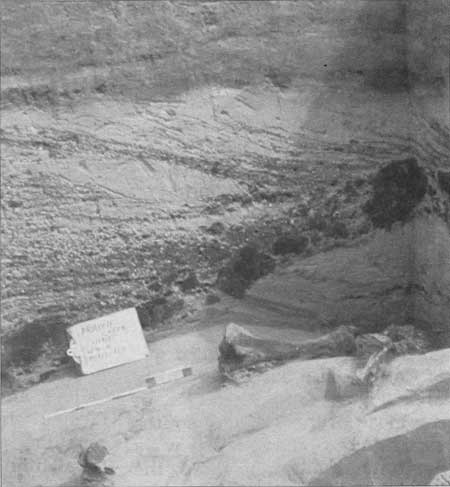
|
|
Figure 23 (right): Mastodon bones exposed within the sediments of
Prairie Creek, Daviess County, IN. Reports of finding large animal bones
by the landowner in 1974 prompted archaeologists to investigate the
site. The excitement of perhaps having found a buried Clovis site led to
two seasons of excavations where many detailed stratigraphic maps were
made of the creek bank deposits and more scattered mastodon bones were
unearthed. After careful study of the creek bank, it was concluded that
thousands of years of flooding had caused Prairie Creek to cut and
refill repeatedly since the Ice Age. The mastodon bones had been moved
and scattered by the creek perhaps many times before coming to rest
where the archaeologists found them. The few prehistoric tools that were
found date to the Middle and Late Archaic periods and these were found
in redeposited soils above those containing the mastodon bones. Indiana
University field school, 1975.
|
At least some of the steep ravines and hollows of the
Hoosier National Forest may have been used as natural surrounds by
Clovis hunters to trap and kill game and make winter camps that would
have been at least partly protected from the wind and cold of the
Arctic-like conditions they endured. We know from geological and pollen
studies that southern Indiana was not covered by glaciers during the
last Ice Age (Wisconsin) between about 19,000 and 13,000 B.C. Even
earlier glaciers by-passed the hill country of south-central Indiana
providing a unique refuge where ice age plants and animals survived when
the rest of Indiana was covered by thick glaciers that had advanced out
of Canada and the Great Lakes area (Figure 24). Therefore, at the close
of the Ice Age, south-central Indiana was environmentally ahead of the
rest of Indiana as the changes
away from Arctic-like conditions slowly gave way to a
warmer climate. The kinds of plants and animals that we are familiar
with today took the place of the Arctic species earlier here than in
northern Indiana.
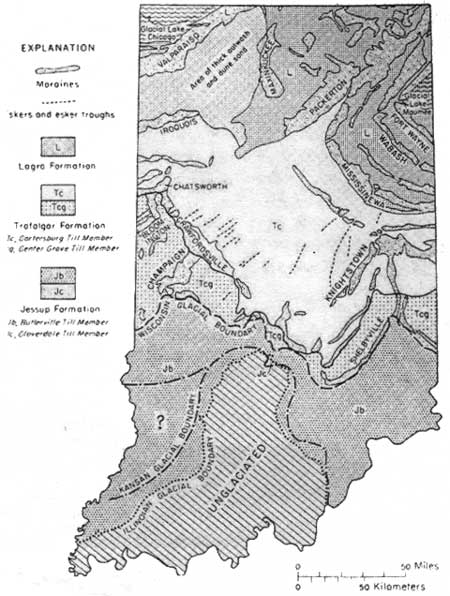
|
|
Figure 24: Map of Indiana showing the extent of
Ice Age (Pleistocene) glaciations (From W. J Wayne "Ice and Land" in
Lindsey 1966: Fig. 8).
|
During the very long process of glacial melting due
to the change in climate, the major river valleys such as the Ohio,
White and Wabash were formed by carrying large amounts of cold glacial
meltwater. The glaciers deposited tremendous amounts of sand, gravel,
and soil within the river valleys and across the land. The glaciers also
formed the landscape over much of Indiana including the many hills and
moraines (e.g. wide, parallel lines of hills marking where glaciers of
ice advanced and then melted back). Plowed fields in
northern Indiana often contain thousands of rounded
and flattened rocks of all sizes that were carried down from Canada by
the glaciers. Glacial melting also caused tributary streams and lowlands
to be flooded creating wide waterways and lakes that eventually shrank
and dried as the climate warmed. However, many swamps and lakes that
existed when the pioneers settled in Indiana were created during the Ice
Age and some remain viable aquatic habitats up to the present time.
The Alton, or Magnet, site in Perry
County is important for our understanding of
Paleoindian occupations of the Hoosier National Forest. It is a large
and important base camp where many Paleoindian projectile points,
including Clovis points, have been found. This site represents a special
location where Clovis and other groups lived, manufacturing new spear
points and other tools, and probably making homes (Figure 25). From this
site, the people geared-up many times for major hunts in the hill
country and valleys of southern Indiana and returned again to eat, rest,
make and repair clothing and shelters, and make new tools.
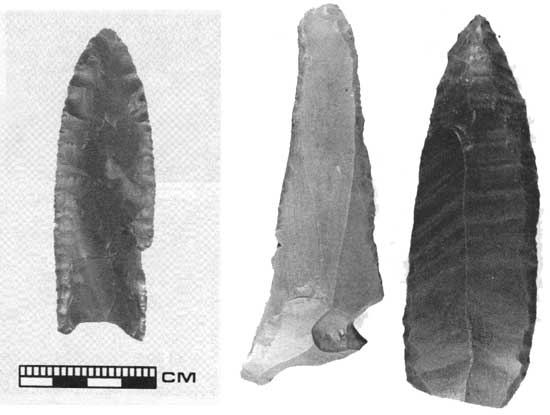
|
|
Figure 25 (above and right): Clovis projectile point and blade tools
made from Wyandotte chert. The blade tools are pressure retouched on the
margins to form edges for cutting meat and scraping hides. These and
many other Paleoindian tools have been found on the surface of the Alton
(Magnet) site in Perry County, IN (Courtesy of Donald Champion).
|
The Potts Creek Rockshelter produced a broken Clovis
point (Figure 26). The projectile point was found in a small pile of
artifacts left on the floor of the shelter by looters after they had
severely churned the shallow deposits for prehistoric artifacts. Sadly,
such looting behavior has ruined some of the better archaeological sites
in the United States and, unless stopped, the last
vestiges of data on America's
first peoples will be lost forever (Figure 27). There are reports from
local persons familiar with the Hoosier National Forest that other
Paleoindian projectile points and tools have been collected from other
rockshelters as well. Such circumstantial evidence suggests that
rockshelters may have been used regularly in south-central Indiana
beginning with Paleoindian occupations in the region as temporary homes
away from larger base camps.
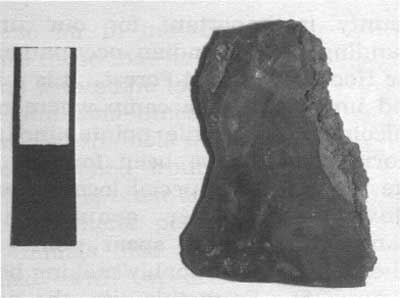
|
|
Figure 26: Clovis point base found in looter's
spoil pile at Potts Creek Rockshelter. The specimen has an
encrustation of calcium carbonate on the break which is common on
ancient tools long buried in damp, chemically rich soil. The point is
also damaged from the heat of a fire. Perhaps long ago while a Clovis
hunter stayed at the shelter for protection from the weather to eat,
relax and repair weapons, he cut the sinew binding and discarded the
broken base in a campfire and then rearmed a spear with a freshly made
Clovis point before leaving to resume hunting. (2 cm scale)
|
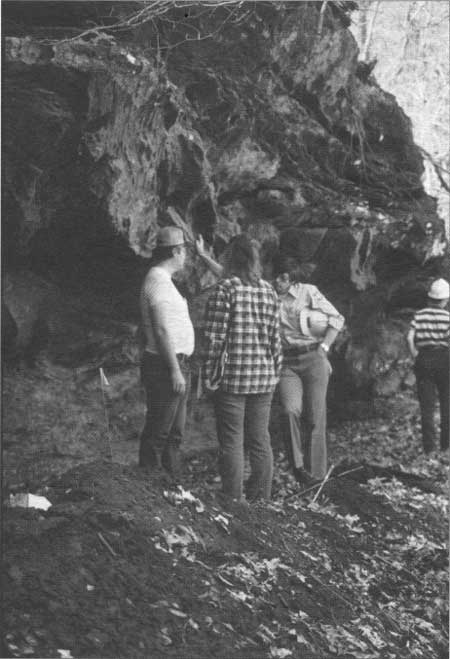
|
|
Figure 27: Archaeologists at Potts Creek Rockshelter discussing the
looting damage and how to proceed in the investigation and
assessment.
|
The archaeological deposits at Rockhouse Hollow
Shelter in Perry County are at least eight feet deep and excavations
there in 1961 by James H. Kellar, with a permit from the Forest Service,
proved that the occupations began during or before the Early Archaic
period (Figure 28). Rocks that had fallen from the roof of the sandstone
alcove and yellow sandy soils were encountered in the
deepest areas excavated at the shelter, but solid bedrock was not
recorded in any of the excavation units. Thus, there remains some
potential for finding a buried Paleoindian or older occupation within
this and other rockshelters. While no bones of Ice Age animals or
other remains were found to indicate the age of the early deposits, the
results of the excavations prove that the rockshelter was open for
occupation and accumulating sediments during this time. It appears when
people realized the attractiveness of a particular shelter, they
returned for thousands of years thereafter (Figure 29). There is also
the distinct possibility that the remains of
some very ancient rockshelters are
now buried and no longer visible on the surface. This happens as a
natural evolution of hillsides and rock exposures as soil erosion takes
place along with the collapse of rock overhangs. In the early 19th
century, farming and clear-cut logging operations also caused severe
erosion of the top soil that added to the deposits along steep slopes
(Figure 30). Ancient buried rockshelters could exist anywhere along the
old ravines of the Hoosier National Forest. While they would be
difficult to detect, some could hold the key to the first peopling of
Indiana during the Ice Age that may be much more ancient than we
presently know (Figures 31-32).
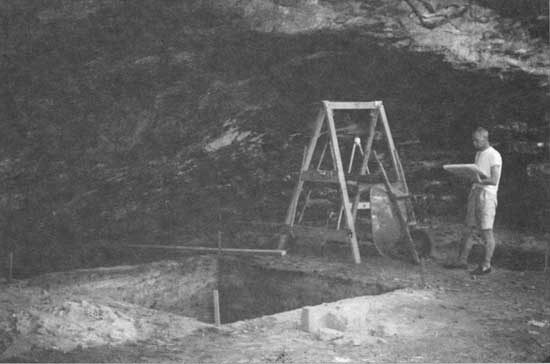
|
|
Figure 28: Record keeping during 1961 excavations within Rockhouse Hollow
Shelter, Perry County, IN. The test excavations by James H. Kellar demonstrated the
deposits were over eight feet deep at the rear of the overhang and the
site contained evidence of human occupations spanning 10,000 years.
|
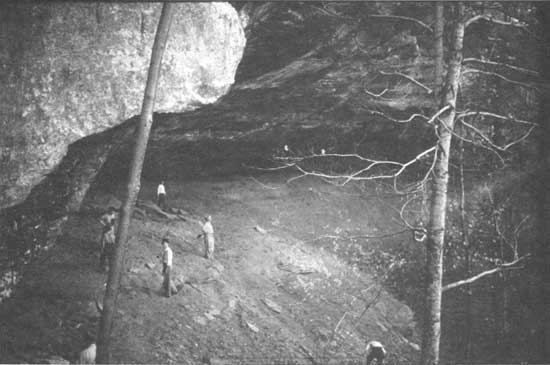
|
|
Figure 29: An early trip to Ash Cave, Perry County, IN. Note the
sandstone rocks (break down) on the floor and slope of the shelter that
have fallen from the roof in the course of natural
weathering over thousands of years. The decomposition
of the rock ledge is largely due to the variation in weather during the
different seasons of the year. Alternating wet and dry and freeze and
thaw cycles causes the rock to break off in sheets and blocks following
naturally weak cracks and lenses within the rock.
|
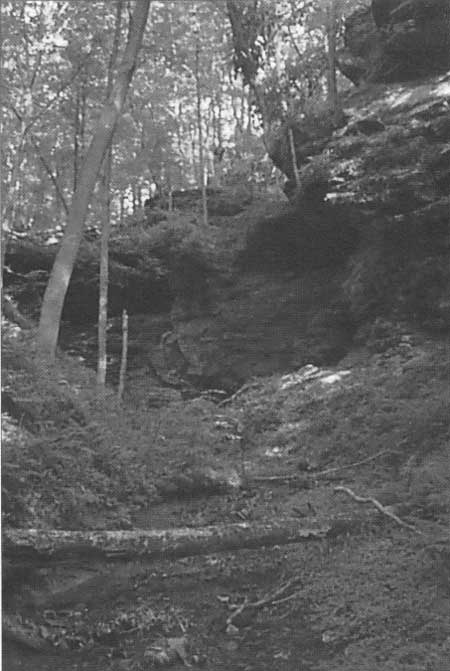
|
|
Figure 30: A rockshelter investigated during the 1999 Hoosier National
Forest archaeological survey. Note the overhang and slope mixed with
soil and rock, fallen from the ceiling and also washed in from the sides
of the overhang.
|
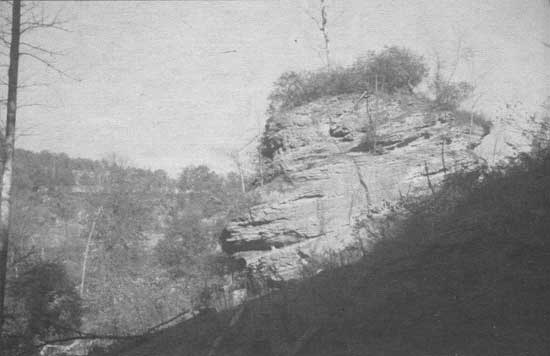
|
|
Figure 31: A hill in Perry County showing a large piece of sandstone
bedrock on the slope. Untold numbers of prehistoric people may have
happened by this place when an ancient rockshelter was still open for
habitation. Today, all such remains are probably buried beneath
weathering sandstone and soil on the hillside.
|
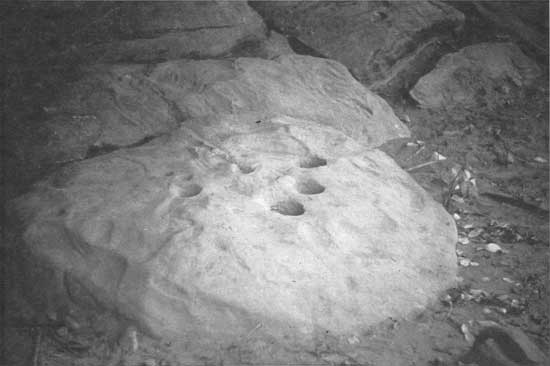
|
|
Figure 32: Prehistoric mortars for processing nuts and other foods on
the floor of Peter Cave in Perry County, IN. These are often referred to
as "bedrock mortars" but they are often large blocks of sandstone fallen
from the roofs of caves and rockshelters that may preserve the remains
of ancient campsites beneath them.
|
9/hoosier/prehistory/sec1.htm
Last Updated: 21-Nov-2008 |
|
















